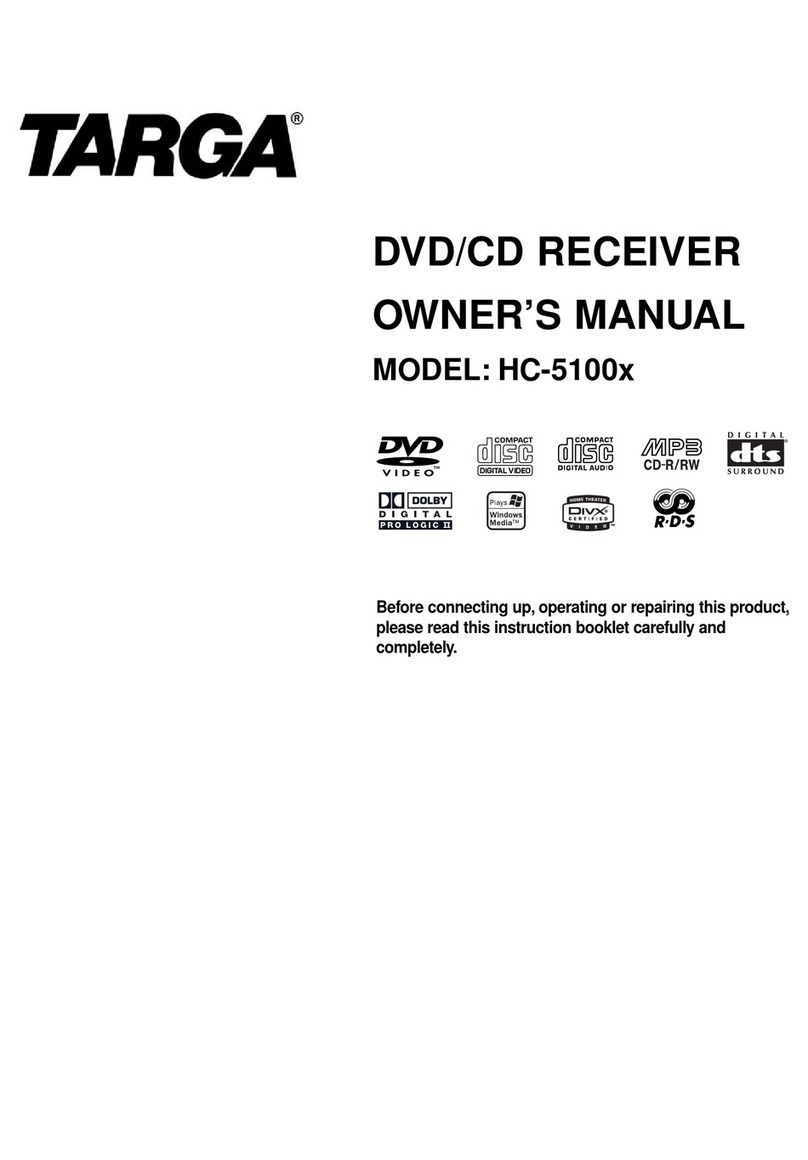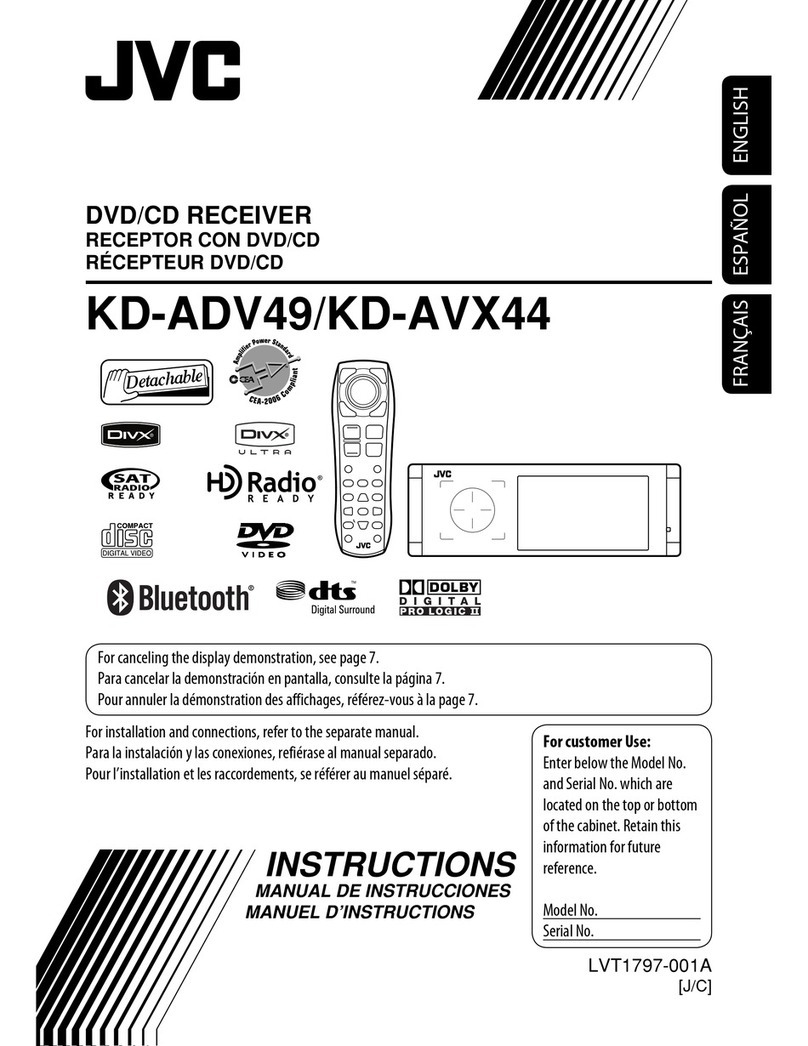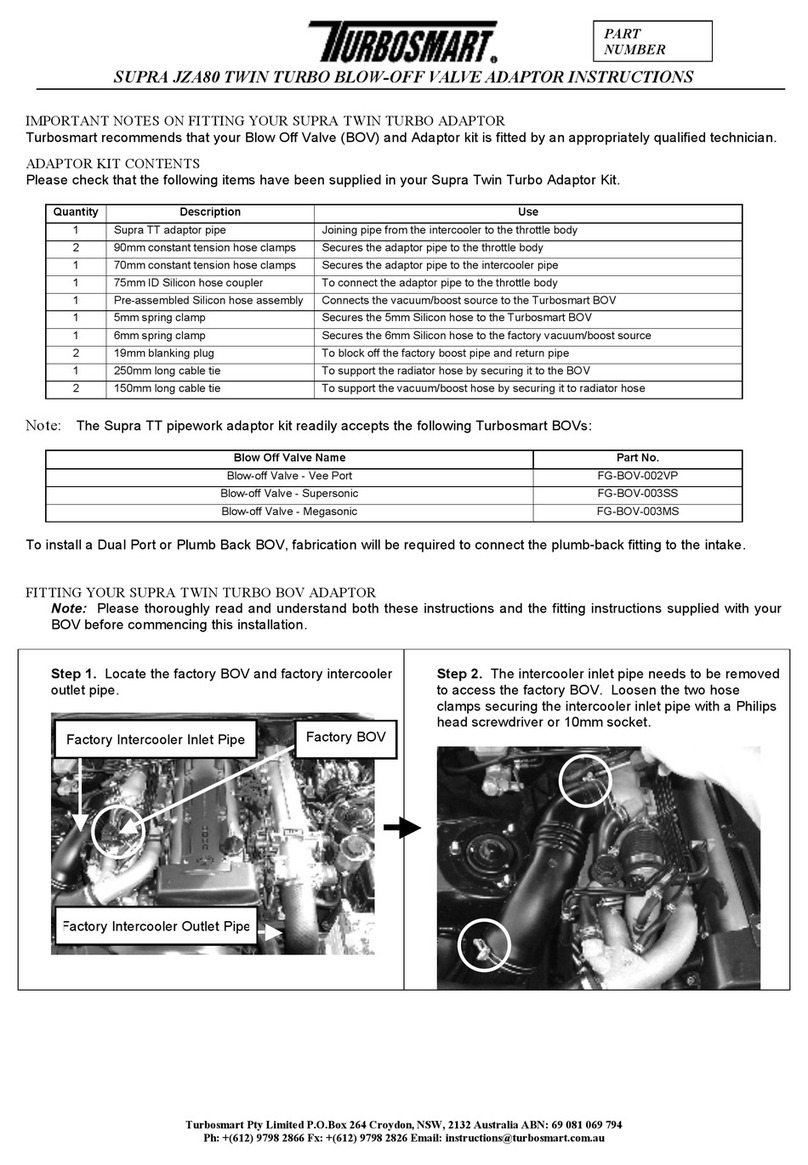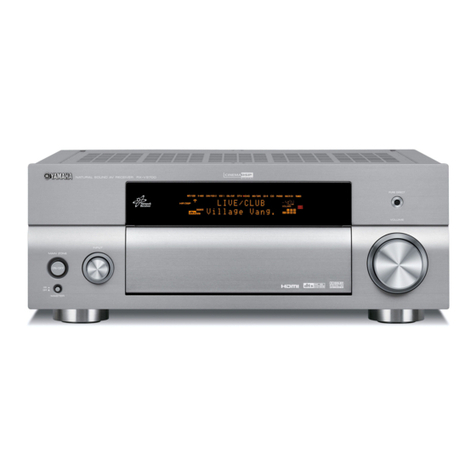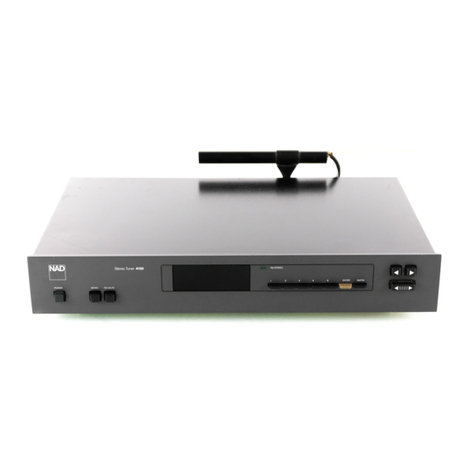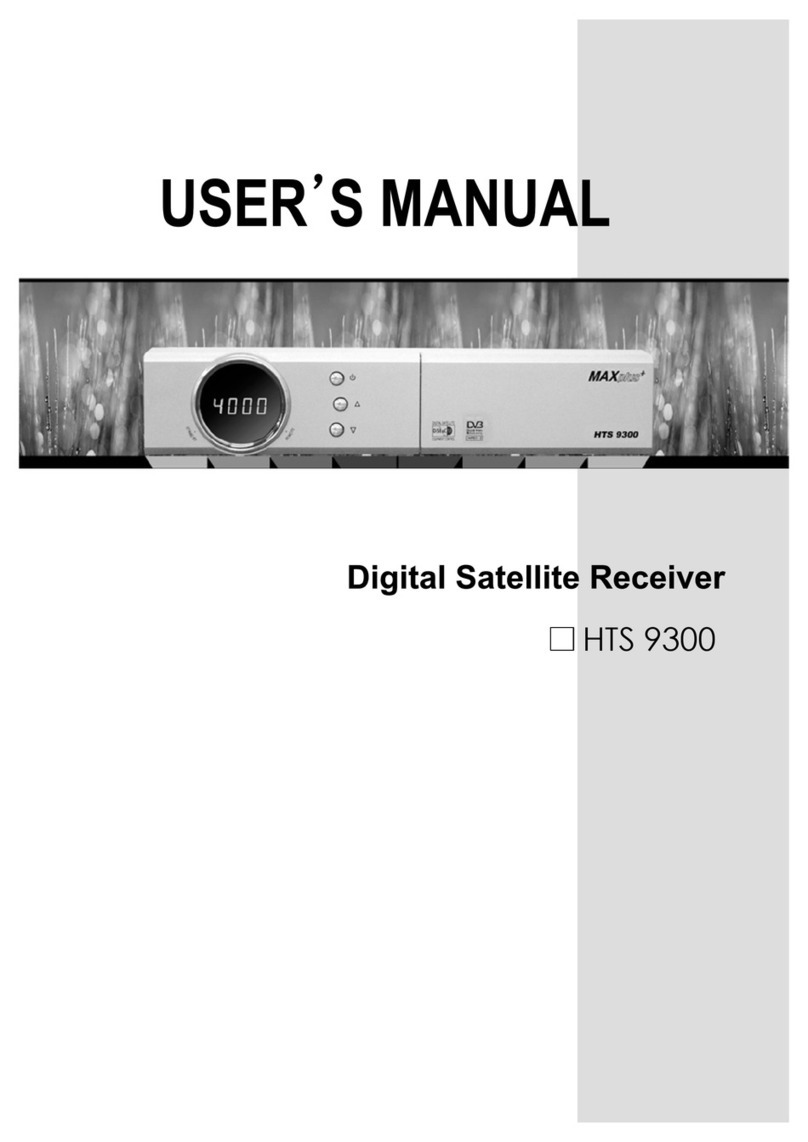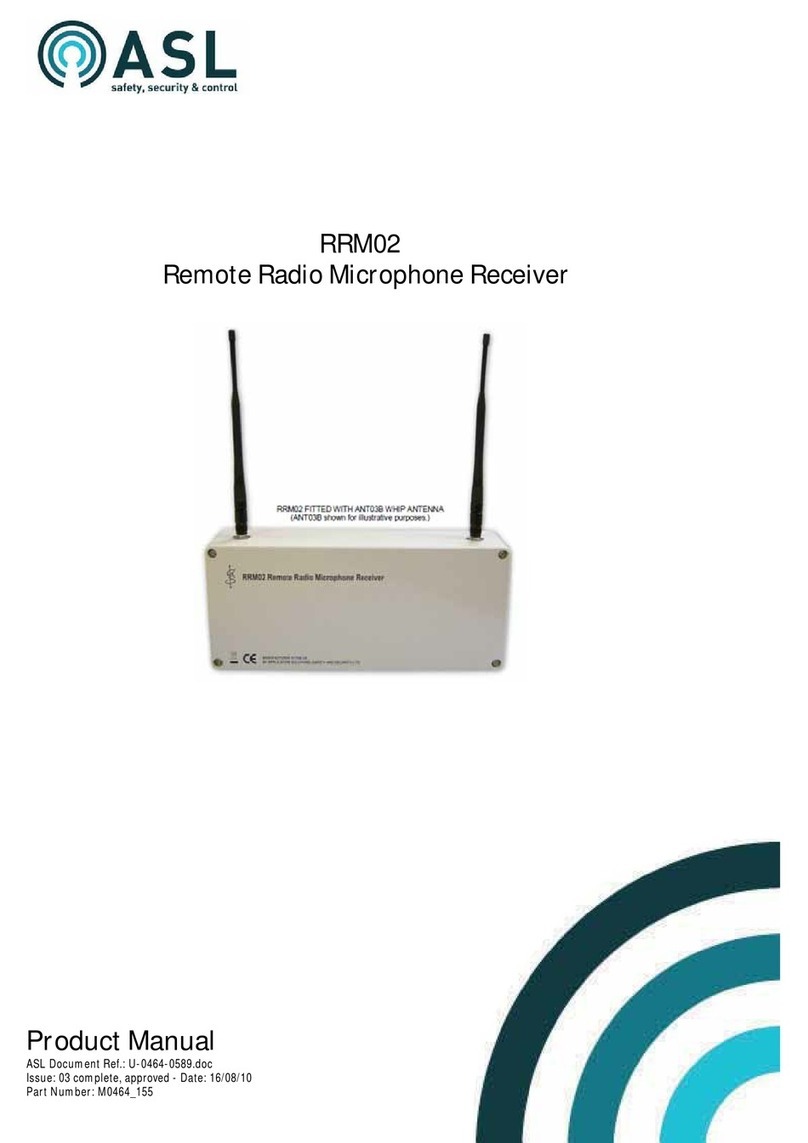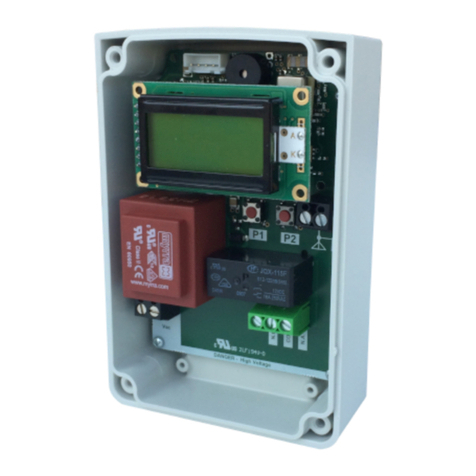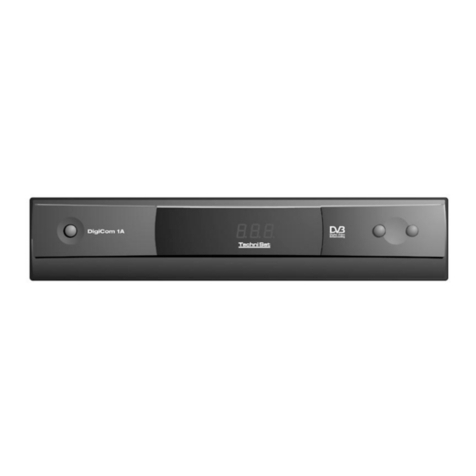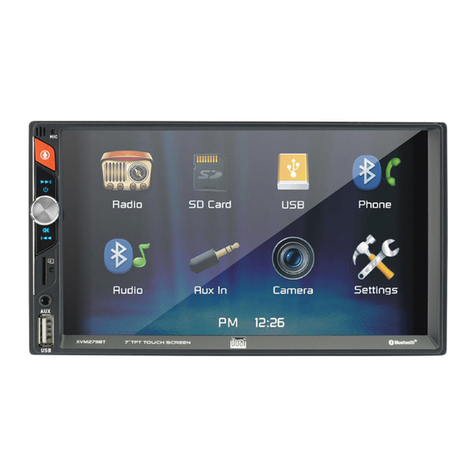Johnson Controls Tyco HSM2HOST User manual

Installation Guide
WARNING: ThisManualcontains informationonlimitations regarding product use andfunctionandinform-
ationonthe limitationsasto liabilityof the manufacturer.The entire manualshouldbe carefully read.
HSM2HOST 2-Way Wireless Transceiver

Table of Contents
Specificationsandfeatures 3
Compatible Devices 3
Safetyinstructions 5
Introduction 6
Controls and indicators 6
Installingthe HSM2HOST 7
Temporary mounting requirements 7
Connecting the HSM2HOST to the alarm panel 7
Enrolling The HSM2HOST 8
Enrollingwirelessdevices 8
Testing the wireless device placement 8
Permanently mounting the HSM2HOST and wireless devices 9
Deletingthe HSM2HOST 9
Wirelessdevicesetup andprogramming 10
[804][001]-[716] Wireless Device Configuration 10
[804][801] RF Jam Detect 10
[804][802] Wireless supervisory time window 11
[804][810] Wireless Option 1 11
[804][841] Motion cameras 12
[804][901]-[905] Deleting wireless devices 12
[804][921]-[925] Replacing wireless devices 12
[804][990][001 – 005] Show all devices 12
[804][999] Reset to factory defaults 13
[904] Placement testing of wireless devices 13
[804][000] Enrolling wireless devices 14
[804][000] Wireless device enrollment – Wireless keys 14
[804][000] Wireless device enrollment – Wireless keypads 15
[804][000] Wireless device enrollment – Wireless repeaters 15
[804][001]-[248] Configure wireless zones 1-248 16
FCCCompliance Statement 22
- 2 -

Specifications and features
lCurrent Draw: 60mA
lVoltage: Draws current from the PowerSeries Neo or PowerSeries Pro alarm controller (10.8VDC
to 12.5VDC) - (Limited Power Supply)
lFrequency: 433MHz (HSM2HOST4), 868MHz (HSM2HOST8), 912-919MHz (HSM2HOST9UL)
lZones - can receive signals from up to 128 wireless zones, plus 16 wireless keypads. Also
supports up to 32 wireless keys or 32 panic pendants
lSupervisory - programmable supervisory window
lCan be wired up to 1000 ft. / 230 m from the main panel with 22 AWG wire
lConnects to Corbus
lCompatibility: The HSM2HOST is used with PowerSeries Neo or PowerSeries Pro alarm panels
lOperating temperature: NA= 0°C – +49°C (32-122°F); EU= -10°C – +55°C
lRelative humidity: 93% non-condensing
lBuilt-in wall and case tampers
lOnly UL/ULC listed devices can be used in UL/ULC listed installations.
lHSM2HOST9 is listed for UL Commercial Burglary, Residential Fire, Residential Burglary and
Home Health Care, ULC Residential Fire and Residential Burglary:
lUL1610 Central-Station Burglar Alarm Units
lUL1023 Household Burglar-Alarm System Units
lUL985 Household Fire Warning System Units
lUL1637 Home Health Care Signaling Equipment
lULC-S545-02 Residential Fire Warning System Control Units
lORD-C1023-1974 Household Burglar-Alarm System Units
lUL 609 Local Burglar Alarm Units and Systems
lUL365 Police Station Connected Burglar Alarm Units and Systems
- 3 -
Compatible devices
The HSM2HOSTx (x= 4/8/9) can receive signals from the devices listed in the following table.
Throughout this document, x in the model number represents the operating frequency of the device for
one of the following models: 9 (912-919 MHz), 8 (868MHz), 4 (433MHz).
Alarm Controllers
Alarm Controllers HS2016/HS2032/HS2064/HS2128/HS3032/HS3128/HS3248
Modules
Wireless keypads HS2LCDWFx/HS2LCDWFPx/HS2LCDWFPVx
Wireless devices Device code
PowerG wireless short range ceiling mount detector with
temperature monitoring PGx862UL
PowerG wireless long range ceiling mount detector with
temperature monitoring PGx872UL
PowerG wireless outdoor curtain PIR PGx902UL
PowerG wireless PRI motion detector with optional animal
resistance PGx904(P)UL
PowerG wireless PIR motion detector with temperature
monitoring PGx914(P)UL

- 4 -
Compatible devices
PowerG wireless curtain PIR motion detector PGx924UL
PowerG wireless PIR motion detector with camera PGx934(P)UL
PowerG wireless outdorr PIR motion detector with camera and
with anti-masking PGx944(P)UL
PowerG wireless mirror optic PIR motion detector PGx974(P)UL
PowerG wireless dual technology (PIR and MW) with anti-
masking PGx984(P)UL
PowerG wireless outdoor PIR motion detector with anti-masking PGx994UL
PowerG wireless recessed door/window contact PGx307UL
PowerG wireless outdoor contact with auxiliary input,
temperature monitoring, and anti-masking PGx312UL
PowerG wireless door/window contact with auxiliary input PGx945UL
PowerG wireless vanishing door/window contact PGx975UL /
PGx303UL
PowerG wireless glassbreak detector PGx912UL /
PGx922UL
PowerG wireless shock detector with auxiliary input PGx935UL
PowerG wireless flood detector PGx985UL
PowerG wireless temperature detector PGx905UL
PowerG wireless temperature probe extender (requires PGx905) PGTEMP-
PROBE
PowerG wireless CO detector (US only) PGx913UL
PowerG wireless CO detector with temperature monitoring PGx933UL
PowerG wireless smoke and heat detector PGx916UL
PowerG wireless smoke and heat detector with temperature
monitoring PGx936UL
PowerG wireless smoke detector PGx926UL
PGx901UL
PowerG wireless outdoor siren PGx911UL
PowerG wireless repeater PGx920UL
PowerG wireless 1-button security panic keyfob PGx938UL
PowerG wireless 2-button security panic keyfob PGx949UL
PGx929UL
PGx939UL
PowerG wireless4-button security panic keyfob PGx929UL
PGx939UL

Safety instructions
- 5 -
Read the safety information before you install the equipment.
IMPORTANT- This equipment must be installed by a skilled person only. A skilled person is an
installer with appropriate technical training. The installer must be aware of potential hazards during
installation and measures available to minimize risks to the installer and other people.
• Before you install this equipment, disconnect all power sources (for example mains, battery, and
telephone line) connected to the alarm panel.
• Install the equipment indoors in a non-hazardous environment where the following conditions are
met:
- Pollution degree - Maximum 2
- Over voltages - Category II
• Internal wiring must be routed to prevent strain on wire and terminal connections, loose terminal
connections, and damage to conductor insulation.
• Instruct the user that there are no user serviceable parts in this equipment. All equipment must be
serviced by a skilled person.

RedLED Operation
Module Power Up: Onsteadyduringmodule power-upsequencethenoff.
Firmware Update: Slow flashing = update in progress
Rapid flashing = update failed
TroubleCondition: lNo trouble: 1 rapid flash every 10 seconds.
If troublesare present,a seriesofflashesoccurevery2seconds.
Eachseriesofflashesindicatetroublesasfollows:
l1 flash: Module not enrolled
l2 flashes: Loss of contact with module for over 60 seconds
l3 flashes: Corbus low voltage
l8 flashes: RF interference (jam condition)
Module Confirmation: Flashesrapidlyduringmodule confirmationprocess.
PlacementTest: Onsteadywhenlocationisbad.Offwhenlocationisgood.
Green LED Operation
PlacementTest: On steady when location is suitable. Off when location is unsuit-
able.
Note: For UL/ULC listed systems, signal must be “Strong”. See
Wireless Device Status Indications on page 10 for details.
Introduction
The HSM2HOSTx two-way wireless transceiver adds wireless capability to alarm controllers,
models HS2016, HS2032, HS2064, HS2128, HS3128, HS3032, and HS3248. This manual
describes how to install, program and maintain the HSM2HOST. Note that only one HSM2HOST
or one RFK keypad can be enrolled on the alarm system.
Controls and indicators
Status LEDs
The LEDs on the front of the HSM2HOST provide feedback regarding the installation, operation
and troubleshooting of the unit. The LEDs function as follows:
Table 1: Status LEDs
Tamper
The HSM2HOST has built-in wall and case tampers. The tamper function is disabled by default on the
NA version (enabled on the EU version). Section [804][810] option 3 on page 10 enables or disables the
tamper function. The case tamper activates when the case is opened and restores when the case is
closed. The wall tamper on the back of the unit is depressed by the mounting surface when properly
installed. If the unit is removed, the tamper activates. Ensure the mounting surface is smooth and free
of obstructions that block access to the rear of the unit. Electrical wires should not run over or under the
module when it is mounted.
Note: The built in wall and case tamper must be installed and enabled for UL/ULC listed Commercial/
Residential Burglary applications.
- 6 -

Installing the HSM2HOST
This section describes how to install the HSM2HOST module.
Temporary mounting requirements
Before installing the HSM2HOST, you must temporarily mount the HSM2HOST in a location that meets
the following requirements.
lEnsure that the location is dry.
lEnsure that the location is within the operating temperature range.
lEnsure that the location is central to the proposed placement of all wireless devices.
lMount the module in a high location. Mounting the module below ground level can reduce the range
of the system.
lMount the module in a location that is far away from sources of interference, such as computers,
electric motors, appliances, heating, air conditioning units, and other sources of electrical noise. Large
metal objects like heating ducts and plumbing can also shield the electromagnetic waves
lEnsure that there are no obstructions blocking the rear of the unit.
Connecting the HSM2HOST to the alarm panel
Caution: Ensure that you disconnect all power supplies from the system before connecting the modules
to the Corbus. Power supplies can include AC, DC, and telephone lines.
To connect the HSM2HOST to the alarm panel, complete the following steps:
1. Connect the HSM2HOST to the four-wire Corbus in the alarm panel. For more information,
see Figure 1.
2. Turn on the system.
Figure 1: Wiring Diagram
- 7 -

Enrolling The HSM2HOST
The enrollment of a HSM2HOST to an alarm panel is dependent on the system configuration.
Enrolling the HSM2HOST without a hardwired keypad
To enroll the HSM2HOST without a hardwired keypad, complete the following steps:
1. Turn on the wireless keypad by connecting the power source.
2. Simultaneously press [*] and [1] on the keypad.
Note: The system can take up to 30 seconds to complete the enrollment
Enrolling the HSM2HOST with an enrolled hardwired keypad
To enroll the HSM2HOST with an enrolled hardwired keypad, complete the following steps:
1. On the enrolled keypad, enter Installer Programming section [902][000] (Auto Enroll All
Modules).
2. When the system prompts you, press [*].
Enrolling the HSM2HOST with only unenrolled hardwired keypads
To enroll the HSM2HOST with only unenrolled hardwired keypad(s), complete the following steps:
1. Enroll only one hardwired keypad onto the system by pressing any key on the keypad.
2. Enter Installer Programming section [902][000](Auto Enroll All Modules).
3. When the system prompts you, press [*] to enroll the HSM2HOST and all other keypads or
modules on the system.
Enrolling wireless devices
To enroll wireless devices, complete the following steps:
1. Enroll all the wireless devices intended to be used in the system. For more information, see
the Wireless device setup and programming section in this manual, in conjuction
with the manual for each wireless device.
2. Temporarily place the wireless devices in their locations of intended use.
Note: You must enroll the HSM2HOST to the alarm panel before you can enroll the
wireless devices.
Testing the wireless device placement
To test the wireless device placement, complete the following steps:
1. Perform a placement test for each wireless device. For more information, see the Place-
ment testing wireless devices section in this manual. Depending on the results of the
placement test, see the following options:
lIf all the results pass the placement test, proceed to the Permanently mounting
the HSM2HOST section of this manual.
lIf all results do not pass the placement test:, move the HSM2HOST to a different loc-
ation, or move the devices that failed the placement test to a different location until all
devices pass the placement test.
- 8 -

Permanently mounting the HSM2HOST and wireless devices
Once you identify a suitable location to permanently mount the HSM2HOST and wireless devices,
complete the following steps:
1. Pull the Corbus wires through the holes at the back of the HSM2HOST cabinet.
2. Using a screwdriver, securely mount the HSM2HOST cabinet of to the wall using the three
screw supplied. For more information, see Figure 2.
3. To install the wall tamper, securely attach the breakaway wall tamper bracket to the wall
using the screws supplied.
4. Install the wireless devices. For more information, refer to the device's Installation Guide.
Figure 1: Mounting the HSM2HOST
Deleting the HSM2HOST
To delete the HSM2HOST, complete the following steps:
1. Using the keypad, enter Installer Programming section [902][106] (Delete HSM2HOSTx).
2. Press [*] to delete.
- 9 -

Wireless device setup and programming
[804][001]-[716] Wireless Device Configuration
To configure wireless devices, complete the following steps:
1. Enter Installer Programming section [804] then select one of the following sub-sections:
l001-248 – Configure Wireless Zones
l601-632 – Configure Wireless Keys
l701-716 – Configure Wireless Keypads
2. Select a device to configure using the scroll keys or go directly to a specific device by entering
a hotkey.
3. Use the scroll buttons or enter a hotkey to select a configuration option for the device. See
device sheets for details.
4. Press [*] to accept and move to the next option.
5. Once all options are configured, the system returns to the base configuration menu.
6. Repeat the process described above to configure other wireless devices.
[804][801] RF Jam Detect
To configure RF jamming, complete the following steps:
1. Enter Installer Programming section [804][801] then select one of the following options:
l00–Disabled
l01–UL20/20-USA
l02–EN30/60-Europe
l03–Class630/60-British
2. Press [*] to accept the selection.
3. Press [#] to exit the section.
- 10 -

[804][802] Wireless supervisory time window
Before programming the wireless supervisory time window, note the following UL/ULC specifications:
UL/ULCspecifications Maximumwirelesssupervisiontime window
ULResidentialBurglary(UL1023) 24hours
HomeHealthCare (UL1637) 24 hours
ULC ResidentialBurglary(ULC/ORD-C1023) 24 hours
ULResidentialFire(UL985)installations 200seconds
ULCommercialBurglary(UL1610/UL365) 4hours
ULC ResidentialFire (ULC-S545) 4hours
Table 2: Status LEDs
To program the wireless supervisory time window, complete the following steps:
1. Enter Installer Programming section [804][802].
2. Select one of the following options by scrolling or entering the hot key:
l00–Disabled
l01–After 1Hour
l02–After 2Hours
l03–After 4Hours
l04–After 8Hours
l05–After 12Hours
l06–After 24Hours
3. Press [*] to accept the selection.
4. Press [#] to exit the section.
For EN installations, 1 hour or 2 hours must be selected.
When option 06 is used, which configures the system to generate fault conditions after a device has
been detected as absent for 24 hours, smoke detectors generate a fault condition after a maximum of
18 hours when the 200s supervision toggle option is disabled.
[804][810] Wireless Option 1
To program wireless options, complete the following steps:
1. Enter Installer Programming section [804][810].
2. Select one of the following options by scrolling or entering the hotkey:
l01–RF Delinquency
l02–WirelessSupervisory/RF Jam Alarm
l03–WirelessTamper
l04–FireSupervision
l05- SmartTemperatureReporting
3. Press [*] to accept the selection and [#] to exit.
- 11 -

[804][841] Motion cameras
To program motion cameras, complete the following steps:
1. Enter Installer Programming section [804][841].
2. Select one of the following options by scrolling or entering the hotkey:
[001] VisualVerification On: Alarms trigger image capture from PIR Cameras
Off: Alarms do not trigger image capture from PIR Cameras
[002] ViewTime Window 01 Alarm + 5 Minutes
02 Alarm + 15 minutes
03 Alarm + 1 Hour
[003] ViewOtherAlarms 01 Fire key enabled/disabled
02 Duress enabled/disabled
03 Medical key enabled/disabled
04 Panic key enabled/disabled
[804][901]-[905] Deleting wireless devices
To delete wireless devices, complete the following steps:
1. Enter Installer Programming section [804] then select one of the following sub-sections:
[901] – Delete wireless zone devices
[902] – Delete wireless key
[904] – Delete repeaters
[905] – Delete keypads
2. Select a device to delete using the scroll keys or go directly to a specific device by entering a
hotkey.
3. Press [*] to delete or [#] to exit.
[804][921]-[925] Replacing wireless devices
To replace a wireless device, complete the following steps:
1. Enter Installer Programming section [804] then select one of the following sub-sections:
[921] – Replace wireless zone devices
[922] – Replace wireless key
[924] – Replace repeaters
[925] – Replace keypads
2. Press [*] to select a sub-section. The first available device is displayed.
3. Select a device to replace using the scroll keys or go to a specific device by entering a hotkey.
4. Press [*]. When prompted, activate the device (full enrollment) or enter the device ID (pre-
enrollment). A message is displayed confirming enrollment.
[804][990][001 – 005] Show all devices
Use this section to review wireless devices enrolled on the system and to view serial numbers associated
with each device.
To review wireless device information, complete the following steps:
1. Enter Installer Programming section [804][990] then select one of the following sub-sections:
l[001]–Allzones
l[002]–Repeaters
l[004]–Wirelesskeys
l[005]–keypads
2. Press [*] to select a wireless device type. The first available device is displayed.
3. Use the scroll keys to view the enrolled devices.
Note: This option is not fully supported by LED and ICON keypads.
- 12 -

[804][999] Reset to factory defaults
Selecting this option resets HSM2HOST programming to factory default settings.
[904] Placement testing of wireless devices
The following test modes are available:
l[904][001]-[248] – Test wireless zones
l[904][521]-[528] – Test all repeaters
l[904][601]-[632] – Test all wireless keys
l[904][701]-[716] – Test all keypads
Two test results are provided:
l24-hour: Average results of signal strength testing over a 24-hour period.
lNow: Signal status results of the current test.
A flashing Trouble LED indicates RF interference. The following status indicators may be displayed:
LCD Icon* LED+ Status
Strong 1 9 Strongsignalstrength
Good 2 10 Goodsignalstrength
Poor 3 11 Poor signalstrength
NotTest 5 13 Displayedasthe Nowresultifnotestwasperformed
NotTest 5 13 Alwaysdisplayedasthe24-hourresultwhentestingwirelesskeys
*For Icon keypads, digit 1 indicates 24-hour test results; digit 2 indicates Now test results.
+For LED keypads, the first digit indicates 24-hour results; the second digit indicates Now test results.
Note: For EN/UL/ULC installations, only STRONG signal levels are acceptable.
- 13 -

[804][000] Enrolling wireless devices
1. Enter Installer Programming section [804][000].
2. When prompted, either activate the device (see device installation sheet) to enroll immediately
or enter a device ID number. Do the latter to pre-enroll devices then enroll them later at the
customer site. The alarm panel determines the type of device being enrolled and presents the
appropriate programming options.
3. Use the scroll keys or type in the corresponding number to select an option.
4. Scroll through the available selections, key in a number or enter text as appropriate.
5. Press [*] to accept and move to the next option.
6. Once all options are configured, the system prompts to enroll the next device.
7. Repeat the process described above until all wireless devices are enrolled.
[804][000] Wireless device enrollment – Wireless keys
Key# Partition# User Label Key# Partition# User Label
1 17
2 18
3 19
4 20
5 21
6 22
7 23
8 24
9 25
10 26
11 27
12 28
13 29
14 30
15 31
16 32
- 14 -

[804][000] Wireless device enrollment – Wireless keypads
WLS
Keypad#
Keypad Assign-
ment Keypad Label WLS
Keypad#
Keypad Assign-
ment Keypad Label
1 9
2 10
3 11
4 12
5 13
6 14
7 15
8 16
[804][000] Wireless device enrollment – Wireless repeaters
Repeater# Repeater label
1
2
3
4
5
6
7
8
- 15 -

[804][001]-[248] Configure wireless zones 1-248
Zone#:
ToggleOptions
[001] Device Options [003] HighTraffic Shutdown
✓01–Alarm LED ✓01–NotActive
✓02–ReedSwitch 02–Yes- NoDelay
03–ExternalInputOn 03–Yes- 5sDelay
✓04–Supervision 04–Yes-15sDelay
05–NotUsed 05–Yes- 30sDelay
06–NotUsed 06–Yes- 1m Delay
07–Anti- Masking 07–Yes- 5m Delay
08–NotUsed 08–Yes- 10m Delay
09–ShockAccumulator 09–Yes- 20m Delay
10–NotUsed 10–Yes- 60m Delay
✓11–24hr/Night [004] Image Brightness
12–Notused 01–ImageBright-3
13–NotUsed 02–ImageBright-2
✓14–FireAlarm 03–ImageBright-1
15–NotUsed ✓04–ImageBright0
16–NotUsed 05–ImageBright+1
[002] Zone EOL 06–ImageBright+2
00–Disable 07–ImageBright+3
✓01–Single EOL
02–NormallyOpen
03–NormallyClosed
04–DoubleEOL
Zone#:
ToggleOptions
[005] Image Contrast [011] - Camera Toggles
01–ImageContrast-3 01- Color
02–ImageContrast-2 02 - High Resolution
03–ImageContrast-1 03-LowQuality
04–ImageContrast-0 04-Microphone
05–Image Contrast+1 05-AC Power
06–ImageContrast+2 [016] Event Counter
07–ImageContrast+3 001-002(Default:002)
- 16 -

Zone#:
ToggleOptions
[006] Detection Range [018] ShockSensitivity
01- LowSensitivity 001-019(Default:008)
02-MidSensitivity [019] HighTemperature Warning
03- HighSensitivity +/-000to999
[007] DetectionSecurity [020] HighTemperature Alarm
01- LowSensitivity +/- 000to999
02- HighSensitivity +/-000to999
03-ULStandard [022] Low Temperature Alarm
+/-000-999c (Default:999c)
[010] Anti-masking
01-Disabled
02-LowSensitivity
03-HighSensitiity
- 17 -

LIMITED WARRANTY
Digital Security Controls warrants the original purchaser that for a
period of twelve months from the date of purchase, the product shall
be free of defects in materials and workmanship under normal use.
During the warranty period, Digital Security Controls shall, at its
option, repair or replace any defective product upon return of the
product to its factory, at no charge for labour and materials. Any
replacement and/or repaired parts are warranted for the remainder of
the original warranty or ninety (90) days, whichever is longer. The
original purchaser must promptly notify Digital Security Controls in
writing that there is defect in material or workmanship, such written
notice to be received in all events prior to expiration of the war-
ranty period. There is absolutely no warranty on software and all
software products are sold as a user license under the terms of the
software license agreement included with the product. The Customer
assumes all responsibility for the proper selection, installation, oper-
ation and maintenance of any products purchased from DSC. Custom
products are only warranted to the extent that they do not function
upon delivery. In such cases, DSC can replace or credit at its option.
International Warranty
The warranty for international customers is the same as for any cus-
tomer within Canada and the United States, with the exception that
Digital Security Controls shall not be responsible for any customs
fees, taxes, or VAT that may be due.
Warranty Procedure
To obtain service under this warranty, please return the item(s) in
question to the point of purchase. All authorized distributors and
dealers have a warranty program. Anyone returning goods to Digital
Security Controls must first obtain an authorization number. Digital
Security Controls will not accept any shipment whatsoever for which
prior authorization has not been obtained.
Conditions to Void Warranty
This warranty applies only to defects in parts and workmanship relat-
ing to normal use. It does not cover:
ldamage incurred in shipping or handling
ldamage caused by disaster such as fire, flood, wind, earth-
quake or lightning;
ldamage due to causes beyond the control of Digital Security
Controls such as excessive voltage, mechanical shock, water
damage;
ldamage caused by unauthorized attachment, alterations, modi-
fications or foreign objects;
ldamage caused by peripherals (unless such peripherals were
supplied by Digital Security Controls Ltd.);
ldefects caused by failure to provide a suitable installation
environment for the products;
ldamage caused by use of the products for purposes other than
those for which it was designed;
ldamage from improper maintenance;
ldamage arising out of any other abuse, mishandling or
improper application of the products.
Items Not Covered by Warranty
In addition to the items which void the Warranty, the following
items shall not be covered by Warranty: (i) freight cost to the
repair centre; (ii) products which are not identified with DSC's
product label and lot number or serial number; (iii) products dis-
assembled or repaired in such a manner as to adversely affect per-
formance or prevent adequate inspection or testing to verify any
warranty claim. Access cards or tags returned for replacement under
warranty will be credited or replaced at DSC's option. Products not
covered by this warranty, or otherwise out of warranty due to age,
misuse, or damage shall be evaluated, and a repair estimate shall be
provided. No repair work will be performed until a valid purchase
order is received from the Customer and a Return Merchandise
Authorization number (RMA) is issued by DSC's Customer Service.
Digital Security Controls Ltd.’s liability for failure to repair the
product under this warranty after a reasonable number of attempts
will be limited to a replacement of the product, as the exclusive
remedy for breach of warranty. Under no circumstances shall Digital
Security Controls be liable for any special, incidental, or con-
sequential damages based upon breach of warranty, breach of con-
tract, negligence, strict liability, or any other legal theory. Such
damages include, but are not limited to, loss of profits, loss of the
product or any associated equipment, cost of capital, cost of sub-
stitute or replacement equipment, facilities or services, down time,
purchaser’s time, the claims of third parties, including customers, and
injury to property. The laws of some jurisdictions limit or do not
allow the disclaimer of consequential damages. If the laws of such a
jurisdiction apply to any claim by or against DSC, the limitations
and disclaimers contained here shall be to the greatest extent per-
mitted by law. Some states do not allow the exclusion or limitation
of incidental or consequential damages, so that the above may not
apply to you.
Disclaimer of Warranties
This warranty contains the entire warranty and shall be in lieu of
any and all other warranties, whether expressed or implied (including
all implied warranties of merchantability or fitness for a particular
purpose) and of all other obligations or liabilities on the part of
Digital Security Controls. Digital Security Controls neither assumes
responsibility for, nor authorizes any other person purporting to act
on its behalf to modify or to change this warranty, nor to assume
for it any other warranty or liability concerning this product. This
disclaimer of warranties and limited warranty are governed by the
laws of the province of Ontario, Canada.
WARNING: Digital Security Controls recommends that the entire sys-
tem be completely tested on a regular basis. However, despite fre-
quent testing, and due to, but not limited to, criminal tampering or
electrical disruption, it is possible for this product to fail to perform
as expected.
Out of Warranty Repairs
Digital Security Controls will at its option repair or replace out-of-
warranty products which are returned to its factory according to the
following conditions. Anyone returning goods to Digital Security Con-
trols must first obtain an authorization number. Digital Security Con-
trols will not accept any shipment whatsoever for which prior
authorization has not been obtained.
Products which Digital Security Controls determines to be repairable
will be repaired and returned. A set fee which Digital Security Con-
trols has predetermined and which may be revised from time to
time, will be charged for each unit repaired.
Products which Digital Security Controls determines not to be repair-
able will be replaced by the nearest equivalent product available at
that time. The current market price of the replacement product will
be charged for each replacement unit.
WARNING – READ CAREFULLY
Note to Installers
This warning contains vital information. As the only individual in
contact with system users, it is your responsibility to bring each
item in this warning to the attention of the users of this system.
System Failures
This system has been carefully designed to be as effective as pos-
sible. There are circumstances, however, involving fire, burglary, or
other types of emergencies where it may not provide protection. Any
alarm system of any type may be compromised deliberately or may
fail to operate as expected for a variety of reasons. Some but not
all of these reasons may be:

Inadequate Installation
A security system must be installed properly in order to provide
adequate protection. Every installation should be evaluated by a
security professional to ensure that all access points and areas are
covered. Locks and latches on windows and doors must be secure
and operate as intended. Windows, doors, walls, ceilings and other
building materials must be of sufficient strength and construction to
provide the level of protection expected. A reevaluation must be
done during and after any construction activity. An evaluation by
the fire and/or police department is highly recommended if this ser-
vice is available.
Criminal Knowledge
This system contains security features which were known to be
effective at the time of manufacture. It is possible for persons with
criminal intent to develop techniques which reduce the effectiveness
of these features. It is important that a security system be reviewed
periodically to ensure that its features remain effective and that it
be updated or replaced if it is found that it does not provide the
protection expected.
Access by Intruders
Intruders may enter through an unprotected access point, circumvent
a sensing device, evade detection by moving through an area of
insufficient coverage, disconnect a warning device, or interfere with
or prevent the proper operation of the system.
Power Failure
Control units, intrusion detectors, smoke detectors and many other
security devices require an adequate power supply for proper oper-
ation. If a device operates from batteries, it is possible for the bat-
teries to fail. Even if the batteries have not failed, they must be
charged, in good condition and installed correctly. If a device oper-
ates only by AC power, any interruption, however brief, will render
that device inoperative while it does not have power. Power inter-
ruptions of any length are often accompanied by voltage fluctuations
which may damage electronic equipment such as a security system.
After a power interruption has occurred, immediately conduct a com-
plete system test to ensure that the system operates as intended.
Failure of Replaceable Batteries
This system’s wireless transmitters have been designed to provide sev-
eral years of battery life under normal conditions. The expected bat-
tery life is a function of the device environment, usage and type.
Ambient conditions such as high humidity, high or low temperatures,
or large temperature fluctuations may reduce the expected battery
life. While each transmitting device has a low battery monitor
which identifies when the batteries need to be replaced, this monitor
may fail to operate as expected. Regular testing and maintenance
will keep the system in good operating condition.
Compromise of Radio Frequency (Wireless) Devices
Signals may not reach the receiver under all circumstances which
could include metal objects placed on or near the radio path or
deliberate jamming or other inadvertent radio signal interference.
System Users
A user may not be able to operate a panic or emergency switch pos-
sibly due to permanent or temporary physical disability, inability to
reach the device in time, or unfamiliarity with the correct oper-
ation. It is important that all system users be trained in the correct
operation of the alarm system and that they know how to respond
when the system indicates an alarm.
Smoke Detectors
Smoke detectors that are a part of this system may not properly
alert occupants of a fire for a number of reasons, some of which fol-
low. The smoke detectors may have been improperly installed or
positioned. Smoke may not be able to reach the smoke detectors,
such as when the fire is in a chimney, walls or roofs, or on the
other side of closed doors. Smoke detectors may not detect smoke
from fires on another level of the residence or building.
Every fire is different in the amount of smoke produced and the
rate of burning. Smoke detectors cannot sense all types of fires
equally well. Smoke detectors may not provide timely warning of
fires caused by carelessness or safety hazards such as smoking in
bed, violent explosions, escaping gas, improper storage of flammable
materials, overloaded electrical circuits, children playing with
matches or arson.
Even if the smoke detector operates as intended, there may be cir-
cumstances when there is insufficient warning to allow all occupants
to escape in time to avoid injury or death.
Motion Detectors
Motion detectors can only detect motion within the designated areas
as shown in their respective installation instructions. They cannot dis-
criminate between intruders and intended occupants. Motion detectors
do not provide volumetric area protection. They have multiple
beams of detection and motion can only be detected in unobstructed
areas covered by these beams. They cannot detect motion which
occurs behind walls, ceilings, floor, closed doors, glass partitions, glass
doors or windows. Any type of tampering whether intentional or unin-
tentional such as masking, painting, or spraying of any material on
the lenses, mirrors, windows or any other part of the detection sys-
tem will impair its proper operation.
Passive infrared motion detectors operate by sensing changes in tem-
perature. However their effectiveness can be reduced when the ambi-
ent temperature rises near or above body temperature or if there are
intentional or unintentional sources of heat in or near the detection
area. Some of these heat sources could be heaters, radiators, stoves,
barbeques, fireplaces, sunlight, steam vents, lighting and so on.
Warning Devices
Warning devices such as sirens, bells, horns, or strobes may not warn
people or waken someone sleeping if there is an intervening wall or
door. If warning devices are located on a different level of the res-
idence or premise, then it is less likely that the occupants will be
alerted or awakened. Audible warning devices may be interfered
with by other noise sources such as stereos, radios, televisions, air
conditioners or other appliances, or passing traffic. Audible warning
devices, however loud, may not be heard by a hearing-impaired per-
son.
Telephone Lines
If telephone lines are used to transmit alarms, they may be out of
service or busy for certain periods of time. Also an intruder may cut
the telephone line or defeat its operation by more sophisticated
means which may be difficult to detect.
Insufficient Time
There may be circumstances when the system will operate as inten-
ded, yet the occupants will not be protected from the emergency
due to their inability to respond to the warnings in a timely man-
ner. If the system is monitored, the response may not occur in time
to protect the occupants or their belongings.
Component Failure
Although every effort has been made to make this system as reli-
able as possible, the system may fail to function as intended due to
the failure of a component.
Inadequate Testing
Most problems that would prevent an alarm system from operating
as intended can be found by regular testing and maintenance. The
complete system should be tested weekly and immediately after a
break-in, an attempted break-in, a fire, a storm, an earthquake, an
accident, or any kind of construction activity inside or outside the
premises. The testing should include all sensing devices, keypads, con-
soles, alarm indicating devices and any other operational devices
that are part of the system.
Security and Insurance
Regardless of its capabilities, an alarm system is not a substitute for
property or life insurance. An alarm system also is not a substitute
for property owners, renters, or other occupants to act prudently to
prevent or minimize the harmful effects of an emergency situation.

IMPORTANT - READ CAREFULLY: DSC Software pur-
chased with or without Products and Components is
copyrighted and is purchased under the following
license terms:
lThis End-User License Agreement (“EULA”) is a legal agree-
ment between You (the company, individual or entity who
acquired the Software and any related Hardware) and Digital
Security Controls, a division of Tyco Safety Products Canada Ltd.
(“DSC”), the manufacturer of the integrated security systems and
the developer of the software and any related products or com-
ponents (“HARDWARE”) which You acquired.
lIf the DSC software product (“SOFTWARE PRODUCT” or
“SOFTWARE”) is intended to be accompanied by HARDWARE,
and is NOT accompanied by new HARDWARE, You may not
use, copy or install the SOFTWARE PRODUCT. The SOFTWARE
PRODUCT includes computer software, and may include asso-
ciated media, printed materials, and “online” or electronic doc-
umentation.
lAny software provided along with the SOFTWARE PRODUCT
that is associated with a separate end-user license agreement is
licensed to You under the terms of that license agreement.
lBy installing, copying, downloading, storing, accessing or oth-
erwise using the SOFTWARE PRODUCT, You agree uncon-
ditionally to be bound by the terms of this EULA, even if this
EULA is deemed to be a modification of any previous arrange-
ment or contract. If You do not agree to the terms of this
EULA, DSC is unwilling to license the SOFTWARE PRODUCT
to You, and You have no right to use it.
SOFTWARE PRODUCT LICENSE
The SOFTWARE PRODUCT is protected by copyright laws and inter-
national copyright treaties, as well as other intellectual property
laws and treaties. The SOFTWARE PRODUCT is licensed, not sold.
1. GRANT OF LICENSE This EULA grants You the following rights:
(a) Software Installation and Use - For each license You acquire,
You may have only one copy of the SOFTWARE PRODUCT
installed.
(b) Storage/Network Use - The SOFTWARE PRODUCT may not be
installed, accessed, displayed, run, shared or used concurrently on or
from different computers, including a workstation, terminal or other
digital electronic device (“Device”). In other words, if You have sev-
eral workstations, You will have to acquire a license for each work-
station where the SOFTWARE will be used.
(c) Backup Copy - You may make back-up copies of the
SOFTWARE PRODUCT, but You may only have one copy per
license installed at any given time. You may use the back-up copy
solely for archival purposes. Except as expressly provided in this
EULA, You may not otherwise make copies of the SOFTWARE
PRODUCT, including the printed materials accompanying the
SOFTWARE.
2. DESCRIPTION OF OTHER RIGHTS AND LIMITATIONS
(a) Limitations on Reverse Engineering, Decompilation and Disas-
sembly - You may not reverse engineer, decompile, or disassemble
the SOFTWARE PRODUCT, except and only to the extent that such
activity is expressly permitted by applicable law notwithstanding this
limitation. You may not make any changes or modifications to the
Software, without the written permission of an officer of DSC. You
may not remove any proprietary notices, marks or labels from the
Software Product. You shall institute reasonable measures to ensure
compliance with the terms and conditions of this EULA.
(b) Separation of Components - The SOFTWARE PRODUCT is
licensed as a single product. Its component parts may not be sep-
arated for use on more than one HARDWARE unit.
(c) Single INTEGRATED PRODUCT - If You acquired this
SOFTWARE with HARDWARE, then the SOFTWARE PRODUCT is
licensed with the HARDWARE as a single integrated product. In this
case, the SOFTWARE PRODUCT may only be used with the
HARDWARE as set forth in this EULA.
(d) Rental - You may not rent, lease or lend the SOFTWARE
PRODUCT. You may not make it available to others or post it on a
server or web site.
(e) Software Product Transfer - You may transfer all of Your rights
under this EULA only as part of a permanent sale or transfer of the
HARDWARE, provided You retain no copies, You transfer all of the
SOFTWARE PRODUCT (including all component parts, the media
and printed materials, any upgrades and this EULA), and provided
the recipient agrees to the terms of this EULA. If the SOFTWARE
PRODUCT is an upgrade, any transfer must also include all prior ver-
sions of the SOFTWARE PRODUCT.
f) Termination - Without prejudice to any other rights, DSC may ter-
minate this EULA if You fail to comply with the terms and con-
ditions of this EULA. In such event, You must destroy all copies of
the SOFTWARE PRODUCT and all of its component parts.
(g) Trademarks - This EULA does not grant You any rights in con-
nection with any trademarks or service marks of DSC or its sup-
pliers.
3. COPYRIGHT - All title and intellectual property rights in and to
the SOFTWARE PRODUCT (including but not limited to any
images, photographs, and text incorporated into the SOFTWARE
PRODUCT), the accompanying printed materials, and any copies of
the SOFTWARE PRODUCT, are owned by DSC or its suppliers. You
may not copy the printed materials accompanying the SOFTWARE
PRODUCT. All title and intellectual property rights in and to the
content which may be accessed through use of the SOFTWARE
PRODUCT are the property of the respective content owner and may
be protected by applicable copyright or other intellectual property
laws and treaties. This EULA grants You no rights to use such con-
tent. All rights not expressly granted under this EULA are reserved
by DSC and its suppliers.
4. EXPORT RESTRICTIONS - You agree that You will not export or
re-export the SOFTWARE PRODUCT to any country, person, or
entity subject to Canadian export restrictions.
5. CHOICE OF LAW - This Software License Agreement is governed
by the laws of the Province of Ontario, Canada.
6. ARBITRATION - All disputes arising in connection with this
Agreement shall be determined by final and binding arbitration in
accordance with the Arbitration Act, and the parties agree to be
bound by the arbitrator’s decision. The place of arbitration shall be
Toronto, Canada, and the language of the arbitration shall be Eng-
lish.
7. LIMITED WARRANTY
(a) NO WARRANTY - DSC PROVIDES THE SOFTWARE “AS IS”
WITHOUT WARRANTY. DSC DOES NOT WARRANT THAT THE
SOFTWARE WILL MEET YOUR REQUIREMENTS OR THAT
OPERATION OF THE SOFTWARE WILL BE UNINTERRUPTED OR
ERROR-FREE.
(b) CHANGES IN OPERATING ENVIRONMENT - DSC shall not be
responsible for problems caused by changes in the operating char-
acteristics of the HARDWARE, or for problems in the interaction of
the SOFTWARE PRODUCT with non-DSC-SOFTWARE or
HARDWARE PRODUCTS.
(c) LIMITATION OF LIABILITY; WARRANTY REFLECTS
ALLOCATION OF RISK - IN ANY EVENT, IF ANY STATUTE
IMPLIES WARRANTIES OR CONDITIONS NOT STATED IN THIS
LICENSE AGREEMENT, DSC’S ENTIRE LIABILITY UNDER ANY
PROVISION OF THIS LICENSE AGREEMENT SHALL BE LIMITED
TO THE GREATER OF THE AMOUNT ACTUALLY PAID BY YOU
TO LICENSE THE SOFTWARE PRODUCT AND FIVE CANADIAN
DOLLARS (CAD$5.00). BECAUSE SOME JURISDICTIONS DO NOT
ALLOW THE EXCLUSION OR LIMITATION OF LIABILITY FOR
CONSEQUENTIAL OR INCIDENTAL DAMAGES, THE ABOVE
LIMITATION MAY NOT APPLY TO YOU.
Other manuals for Tyco HSM2HOST
1
Table of contents
Languages:
Other Johnson Controls Receiver manuals
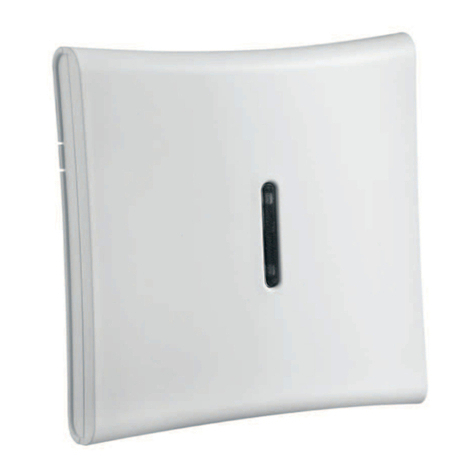
Johnson Controls
Johnson Controls Tyco HSM2HOST User manual
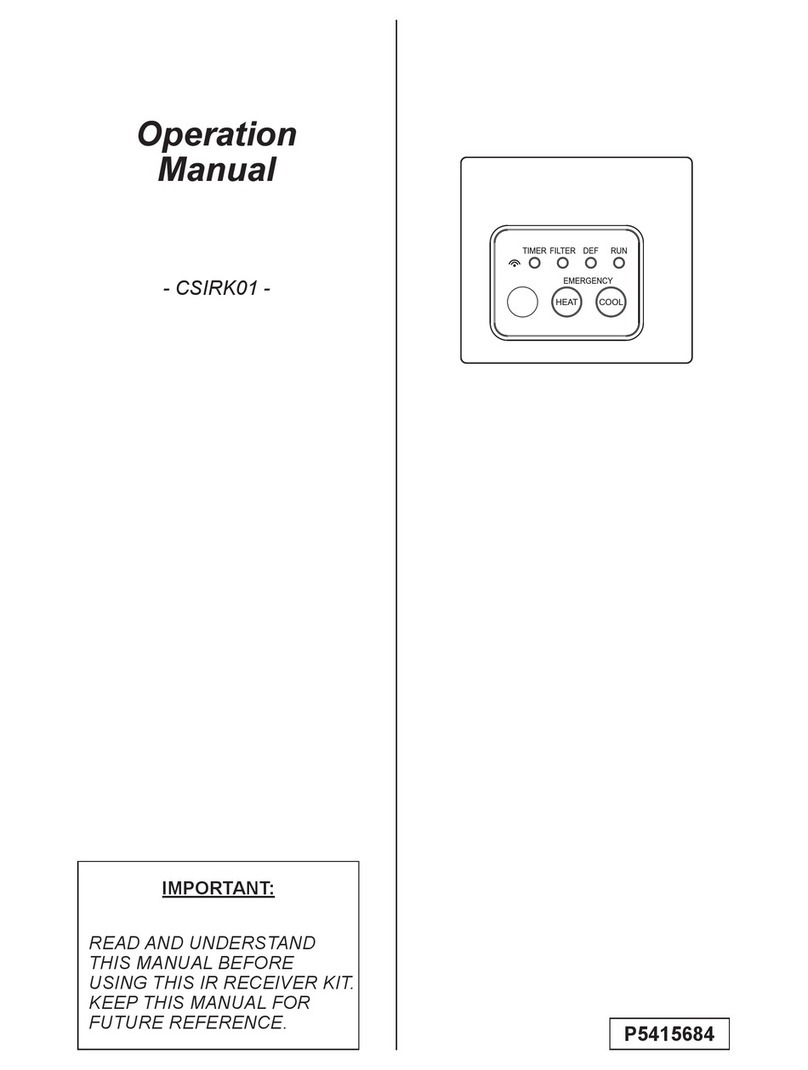
Johnson Controls
Johnson Controls CSIRK01 User manual
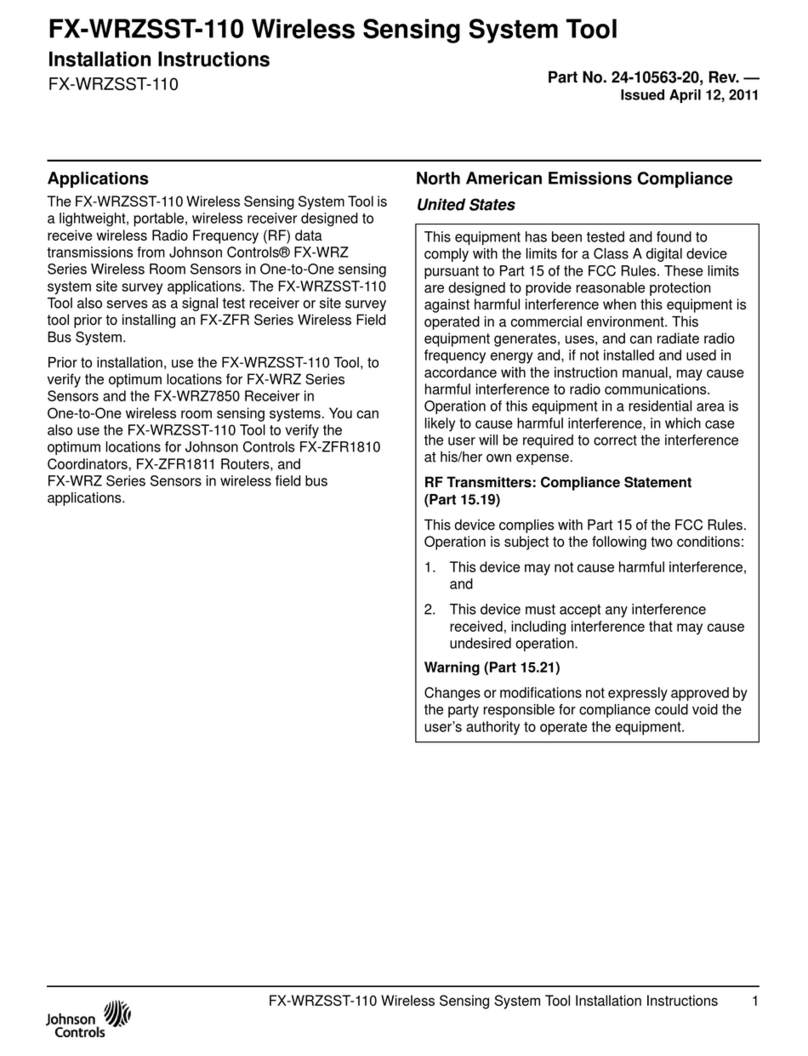
Johnson Controls
Johnson Controls FX-WRZSST-110 User manual
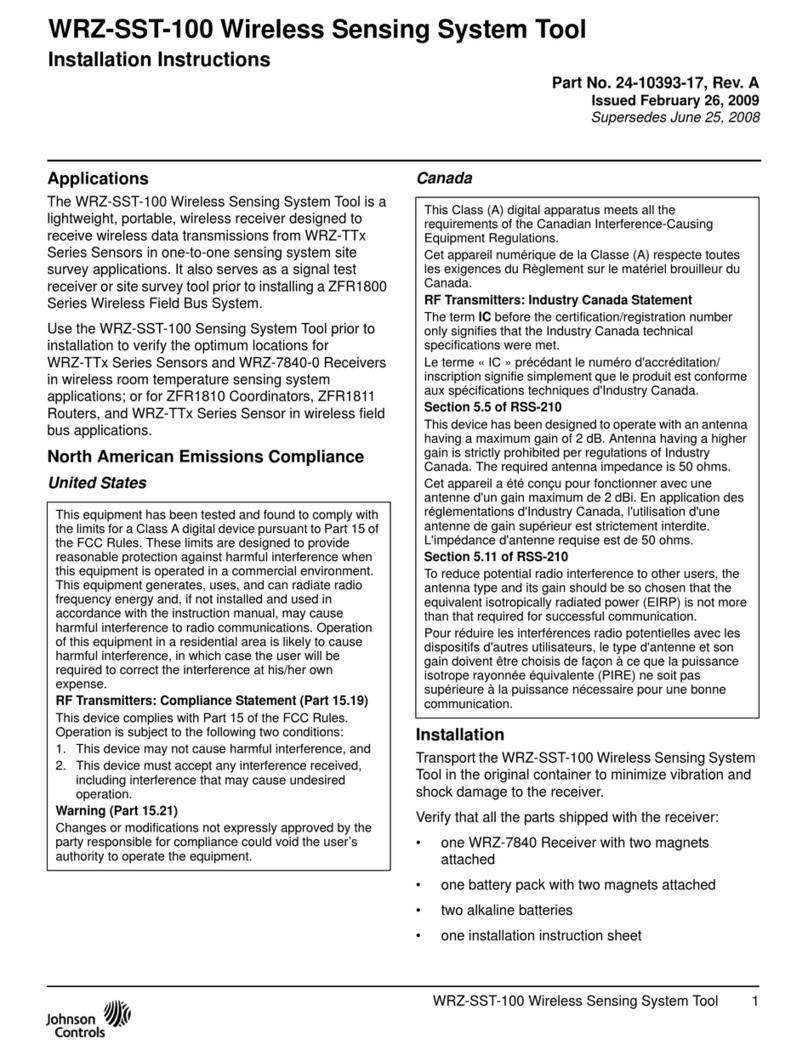
Johnson Controls
Johnson Controls WRZ-SST-10 User manual
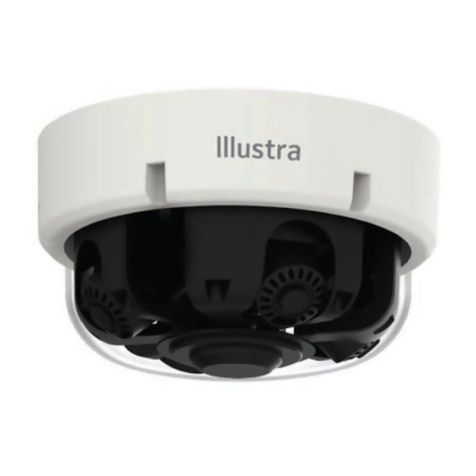
Johnson Controls
Johnson Controls Illustra PRO Pro Gen4 Multisensor Dome Conduit... User manual
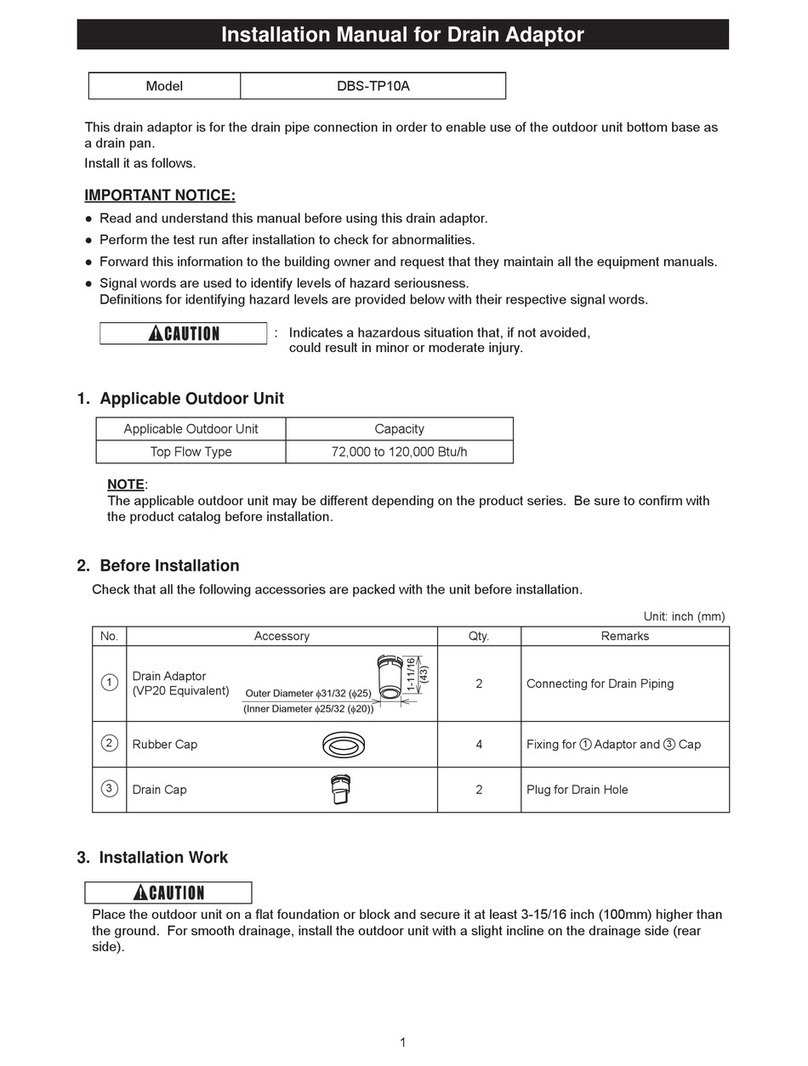
Johnson Controls
Johnson Controls DBS-TP10A User manual
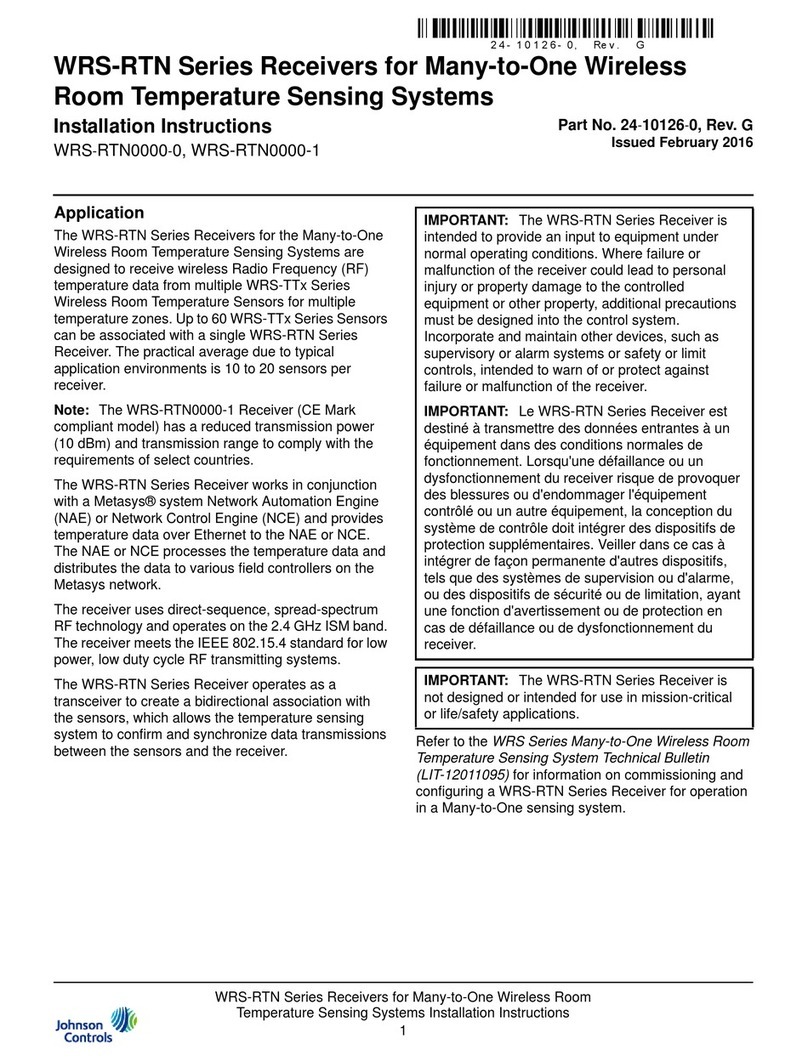
Johnson Controls
Johnson Controls WRS-RTN0000-0 User manual

Johnson Controls
Johnson Controls CSIRK01 User manual

Johnson Controls
Johnson Controls WRZ-7860-0 User manual

